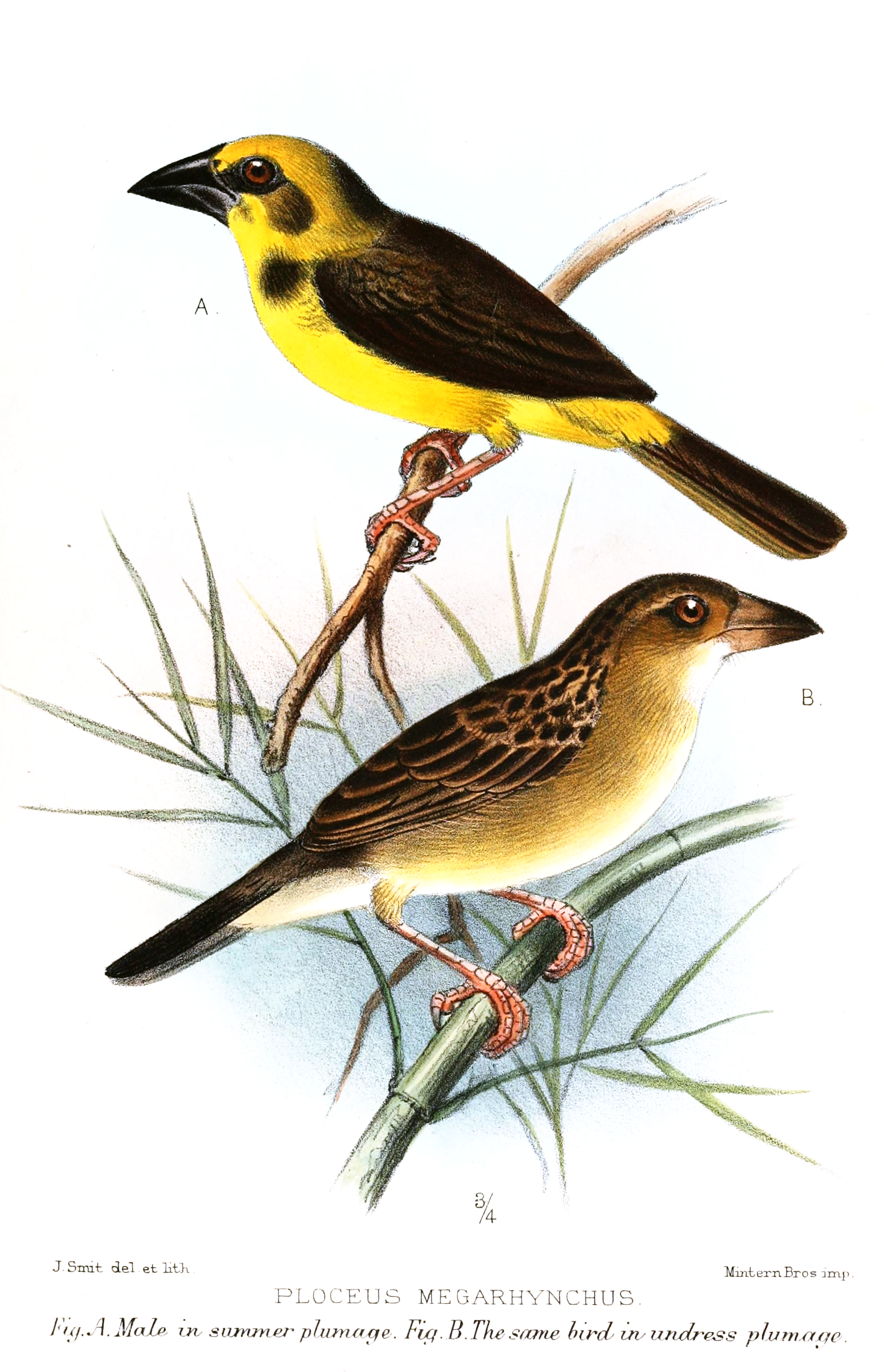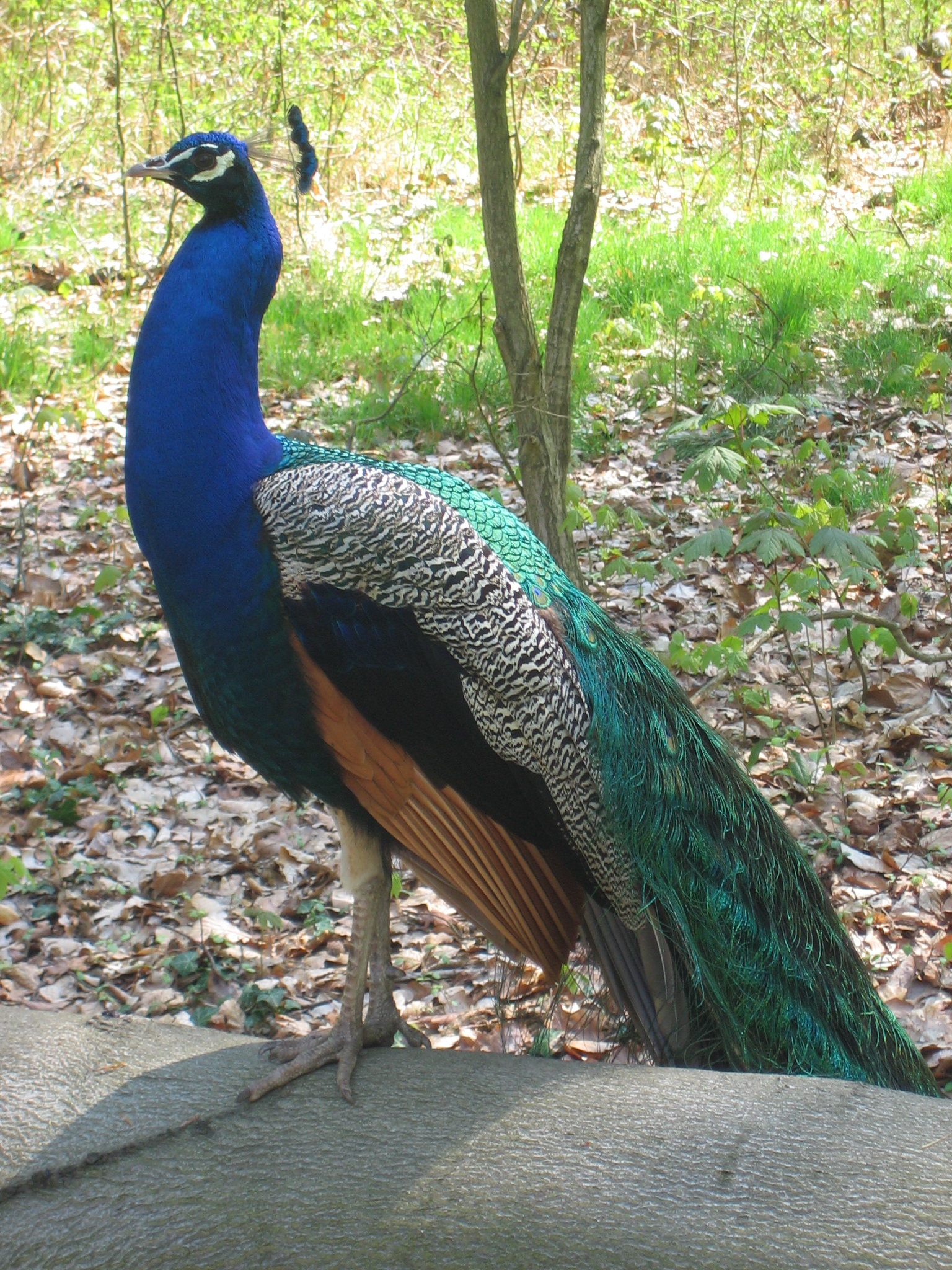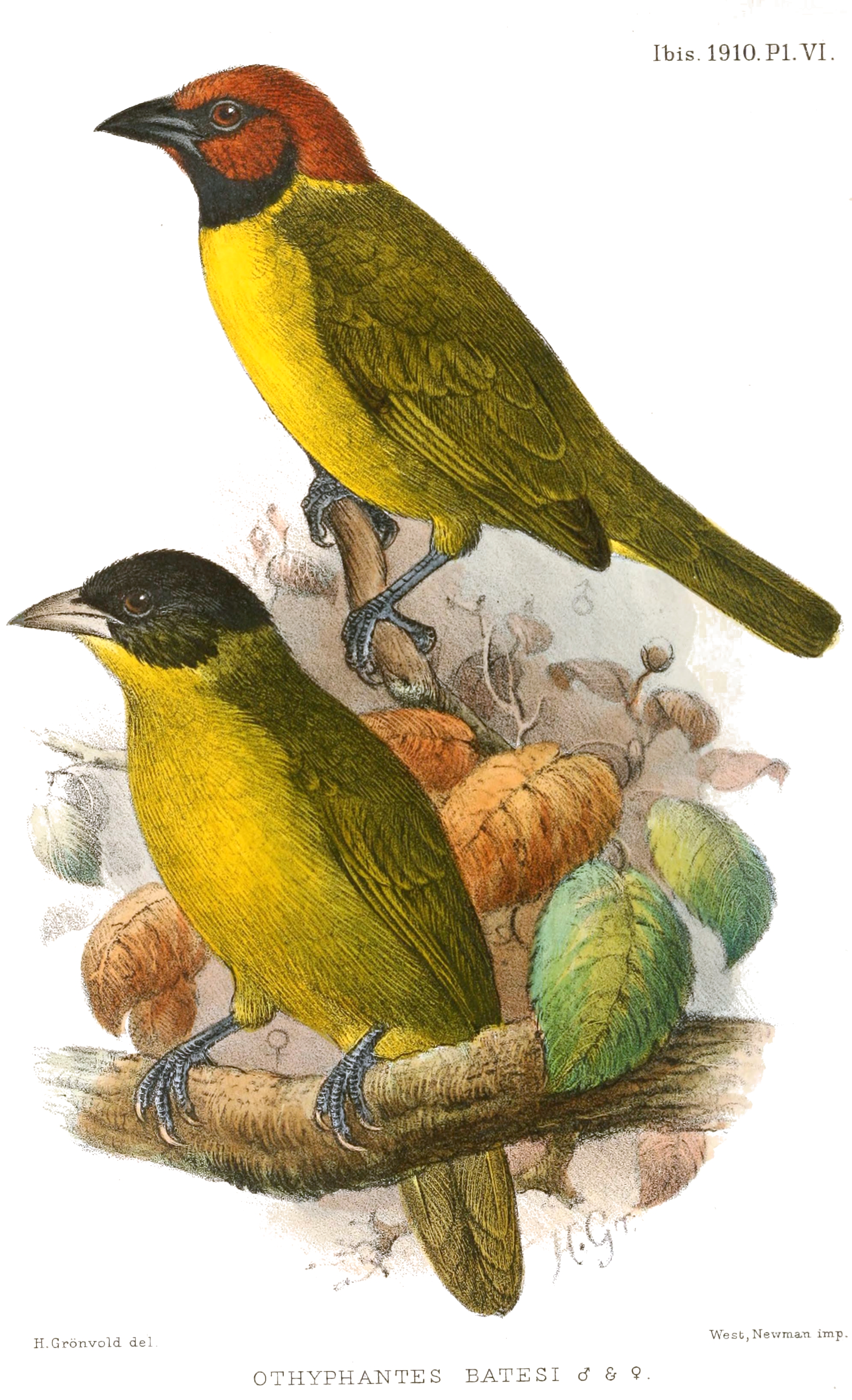|
Finn's Weaver
Finn's weaver (''Ploceus megarhynchus''), also known as Finn's baya and yellow weaver is a weaver bird species native to the Ganges and Brahmaputra valleys in India and Nepal. Two subspecies are known; the nominate subspecies occurs in the Kumaon area and ''salimalii'' in the eastern Terai. The species was described and given its binomial name by Allan Octavian Hume based on a specimen obtained at Kaladhungi near Nainital. Etymology The species was called "Eastern baya" by Oates in 1889 and called Finn's baya after Frank Finn by E. C. Stuart Baker in 1925. Distribution and habitat Finn's weaver was first observed in Shuklaphanta National Park in May 1996 and is a regular summer visitor. Behaviour and ecology Finn's weaver breeds from May to September.BirdLife International (2009) Species factsheet: ''Ploceus megarhynchus''BirdLife International: ''Yellow Weaver''/ref> It builds a nest on top of trees or in reeds. The nest is different in structure from the other weaver ... [...More Info...] [...Related Items...] OR: [Wikipedia] [Google] [Baidu] |
Uttarakhand
Uttarakhand (, ), also known as Uttaranchal ( ; List of renamed places in India, the official name until 2007), is a States and union territories of India, state in North India, northern India. The state is bordered by Himachal Pradesh to the northwest, Tibet to the north, Nepal to the east, Uttar Pradesh to the south and southeast, with a small part touching Haryana in the west. Uttarakhand has a total area of , equal to 1.6% of the total area of India. Dehradun serves as the state capital, with Nainital being the judicial capital. The state is divided into two divisions, Garhwal division, Garhwal and Kumaon division, Kumaon, with a total of List of districts of Uttarakhand, 13 districts. The forest cover in the state is 45.4% of the state's geographical area. The cultivable area is 16% of the total geographical area. The two major rivers of the state, the Ganges and its tributary Yamuna, originate from the Gangotri and Yamunotri glaciers respectively. Ranked 6th among the Top 1 ... [...More Info...] [...Related Items...] OR: [Wikipedia] [Google] [Baidu] |
Birds Of Nepal
Birds are a group of warm-blooded vertebrates constituting the class Aves (), characterised by feathers, toothless beaked jaws, the laying of hard-shelled eggs, a high metabolic rate, a four-chambered heart, and a strong yet lightweight skeleton. Birds live worldwide and range in size from the bee hummingbird to the common ostrich. There are over 11,000 living species and they are split into 44 orders. More than half are passerine or "perching" birds. Birds have wings whose development varies according to species; the only known groups without wings are the extinct moa and elephant birds. Wings, which are modified forelimbs, gave birds the ability to fly, although further evolution has led to the loss of flight in some birds, including ratites, penguins, and diverse endemic island species. The digestive and respiratory systems of birds are also uniquely adapted for flight. Some bird species of aquatic environments, particularly seabirds and some waterbir ... [...More Info...] [...Related Items...] OR: [Wikipedia] [Google] [Baidu] |
Birds Of India
This is a list of the bird species of India and includes Extant taxon, extant and recently extinct species recorded within the political limits of the Republic of India as defined by the Indian government. There have been 1393 species recorded as of 2025, of which 84 are Endemism in birds, endemic to the country. 98 species are globally threatened. The Indian peafowl (''Pavo cristatus'') is the national bird of India. This list does not cover species in Indian jurisdiction areas such as Dakshin Gangotri and oceanic species are delineated by an arbitrary cutoff distance. The list does not include fossil bird species or escapees from captivity. This list's Taxonomy (biology), taxonomic treatment (designation and sequence of orders, families and species) and nomenclature (common and scientific names) follow the conventions of the IOC World Bird List, version 13.1. This list also uses British English throughout. Any bird names or other wording follows that convention. The following ... [...More Info...] [...Related Items...] OR: [Wikipedia] [Google] [Baidu] |
Ploceus
''Ploceus'' is a genus (biology), genus of birds in the Ploceidae, weaver family (biology), family, Ploceidae. They are native to the Indomalayan realm, Indomalayan and Afrotropical realms. Taxonomy and systematics Phylogeny The genus ''Ploceus'' was introduced by the French naturalist Georges Cuvier in 1816. The type species was subsequently designated as the baya weaver. The genus name is from Ancient Greek πλοκευς ''plokeus'' meaning "weaver", and is derived from the Greek word πλεκω ''plekō'' "to entwine". Based on recent DNA phenotyping, DNA-analysis, the genus ''Ploceus'' is almost certainly Polyphyly, polyphyletic. If all species currently included in the genus would remain and the genus would be made monophyletic, it would have to encompass the entire subfamily Ploceinae. The Ploceinae can be divided into two groups. In the first group, the widowbirds and bishops (genus ''Euplectes'') are sister to a clade in which the genera ''Foudia'' and ''Quelea'' ar ... [...More Info...] [...Related Items...] OR: [Wikipedia] [Google] [Baidu] |
Newsletter For Birdwatchers
''Newsletter for Birdwatchers'' is an Indian periodical of ornithology and birdwatching founded in 1960 by Zafar Futehally, who edited it until 2003. It was initially mimeographed and distributed to a small number of subscribers each month. It is one of the oldest periodicals devoted to ornithology in India. The editorial board in its early years included Salim Ali, Biswamoy Biswas and other ornithologists in the region. The present editorial board includes many ornithologists, viz., Dr. A.M.K. Bharos, Dr. S.P. Bhatnagar, Dr. A.K. Chakravarthy, Dr. Ranjan Kumar Das, Dr. S. Devasahayam, Dr. Raju Kasambe, B.S. Kulkarni, Dr. Dipankar Lahkar, Arvind Mishra, Dr. Geeta S. Padate, K. Mrutumjaya Rao, A.N. Yellappa Reddy, Dr. Rajiv Saxena, Dr. A.B. Shanbhag, Arunayan Sharma, Dr. Hiren B. Soni, S. Shreyas, S. Sridhar and Dr. Abraham Verghese as in January 2022. The nature of the articles are largely informal and often essay-like. Important observations were often republished in other journal ... [...More Info...] [...Related Items...] OR: [Wikipedia] [Google] [Baidu] |
Shuklaphanta National Park
Shuklaphanta National Park is a national park in the Terai of the Far-Western Region, Nepal, covering of open grasslands, forests, riverbeds and wetlands at an elevation of . It is bounded by the Mahakali river in the west and south. A small part extends north of the Mahendra Highway to create a wildlife corridor for seasonal migration of wildlife into the Sivalik Hills. It was gazetted in 1976 as ''Royal Shuklaphanta Wildlife Reserve'' and was enlarged to its present size in the late 1980s. A buffer zone of was added in 2004. It receives a mean annual rainfall of and harbours 700 floral, 456 bird, 56 reptile and 15 amphibian species. History The name ''Shuklaphanta'' was derived from one of the grasslands called inside the protected area. The main grassland called ''Shukla Phanta'' is the largest patch of continuous grassland in Nepal covering an area of about . The area was a favourite hunting ground for Nepal's ruling class and was declared a ''Royal Hunting Reserve'' i ... [...More Info...] [...Related Items...] OR: [Wikipedia] [Google] [Baidu] |
Frank Finn
Frank Finn FZS, MBOU (1868 – 1 October 1932) was an English ornithologist. Finn was born in Maidstone and educated at Maidstone Grammar School and Brasenose College, Oxford. He went on a collecting expedition to East Africa in 1892, and became First Assistant Superintendent of the Indian Museum, Calcutta in 1894, and Deputy Superintendent from 1895 to 1903. He then returned to England, and was editor of the '' Avicultural Magazine'' in 1909–10. Finn was a prolific author, his works including ''Garden and Aviary Birds of India'', ''How to Know the Indian Ducks'' (1901), ''The Birds of Calcutta'' (1901), ''How to Know the Indian Waders'' (1906), ''Ornithological and other Oddities'' (1907), ''The Making of Species'' (1909, with Douglas Dewar), ''Eggs and Nests of British Birds'' (1910) and ''Indian Sporting Birds'' (1915). He also edited Robert A. Sterndale's book on the mammals of India and Ceylon and brought out a new and abridged edition titled ''Sterndale's Mamma ... [...More Info...] [...Related Items...] OR: [Wikipedia] [Google] [Baidu] |
Eugene W
Eugene may refer to: People and fictional characters * Eugene (given name), including a list of people and fictional characters with the given name * Gene Eugene, stage name of Canadian born actor, record producer, engineer, composer and musician Gene Andrusco (1961–2000) * Eugene (wrestler), professional wrestler Nick Dinsmore * Eugene (actress) (born 1981), Kim Yoo-jin, South Korean actress and former member of the singing group S.E.S. Places Canada * Mount Eugene, in Nunavut; the highest mountain of the United States Range on Ellesmere Island United States * Eugene, Oregon Eugene ( ) is a city in and the county seat of Lane County, Oregon, United States. It is located at the southern end of the Willamette Valley, near the confluence of the McKenzie River (Oregon), McKenzie and Willamette River, Willamette rivers, ..., a city ** Eugene, OR Metropolitan Statistical Area ** Eugene (Amtrak station) * Eugene Apartments, NRHP-listed apartment complex in Port ... [...More Info...] [...Related Items...] OR: [Wikipedia] [Google] [Baidu] |
Nainital
Nainital (Kumaoni language, Kumaoni: ''Naintāl''; ) is a town and headquarters of Nainital district of Kumaon division, Uttarakhand, India. It is the judicial capital of Uttarakhand, the Uttarakhand High Court, High Court of the state being located there and is the headquarters of Nainital district, an eponymous district. It also houses the Governor of Uttarakhand, who resides in the Raj Bhavan, Nainital, Raj Bhavan. Nainital was the summer capital of the United Provinces of Agra and Oudh, United Provinces. Nainital is located in the Kumaon division, Kumaon foothills of the outer Himalayas at a distance of from the state capital Dehradun and from New Delhi, the capital of India. Situated at an altitude of above sea level, the town is set in a valley containing an Nainital Lake, eye-shaped lake, approximately two miles in circumference, and surrounded by mountains, of which the highest are Naina Peak () on the north, Deopatha () on the west, and Ayarpatha () on the south. F ... [...More Info...] [...Related Items...] OR: [Wikipedia] [Google] [Baidu] |
Allan Octavian Hume
Allan Octavian Hume, Order of the Bath, CB Indian Civil Service, ICS (4 June 1829 – 31 July 1912) was a British political reformer, ornithologist, civil servant and botanist who worked in British Raj, British India and was the founding spirit and key founder of the Indian National Congress. He was a proponent of Indian self-rule and strongly supported the idea of Indian independence. He supported the idea of self-governance by Indians. A notable ornithologist, Hume has been called "the Father of Indian Ornithology" and, by those who found him dogmatic, "the Pope of Indian Ornithology". As the collector of Etawah, he saw the Indian Rebellion of 1857 as a result of misgovernance and made great efforts to improve the lives of the common people. The district of Etawah was among the first to be returned to normality and over the next few years Hume's reforms led to the district being considered a model of development. Hume rose in the ranks of the Indian Civil Service (British India ... [...More Info...] [...Related Items...] OR: [Wikipedia] [Google] [Baidu] |
Terai
The Terai or Tarai is a lowland region in parts of southern Nepal and northern India that lies to the south of the outer foothills of the Himalayas, the Sivalik Hills and north of the Indo-Gangetic Plain. This lowland belt is characterised by tall grasslands, scrub savannah, sal forests and clay rich swamps. In North India, the Terai spreads from the Yamuna River eastward across Haryana, Uttarakhand, Uttar Pradesh, Bihar and West Bengal. The Terai is part of the Terai-Duar savanna and grasslands ecoregion. Nepal's Terai stretches over , about 23.1% of Nepal's land area, and lies at an elevation of between . The region comprises more than 50 wetlands. North of the Terai rises the Bhabar, a narrow but continuous belt of forest about wide. Etymology The Urdu word tarāʼī means "lands lying at the foot of a watershed" or "on the banks of a river; low ground flooded with water, valley, basin, marshy ground, marsh, swamp; meadow". In Hindi, the region is called 'tarāī' m ... [...More Info...] [...Related Items...] OR: [Wikipedia] [Google] [Baidu] |








